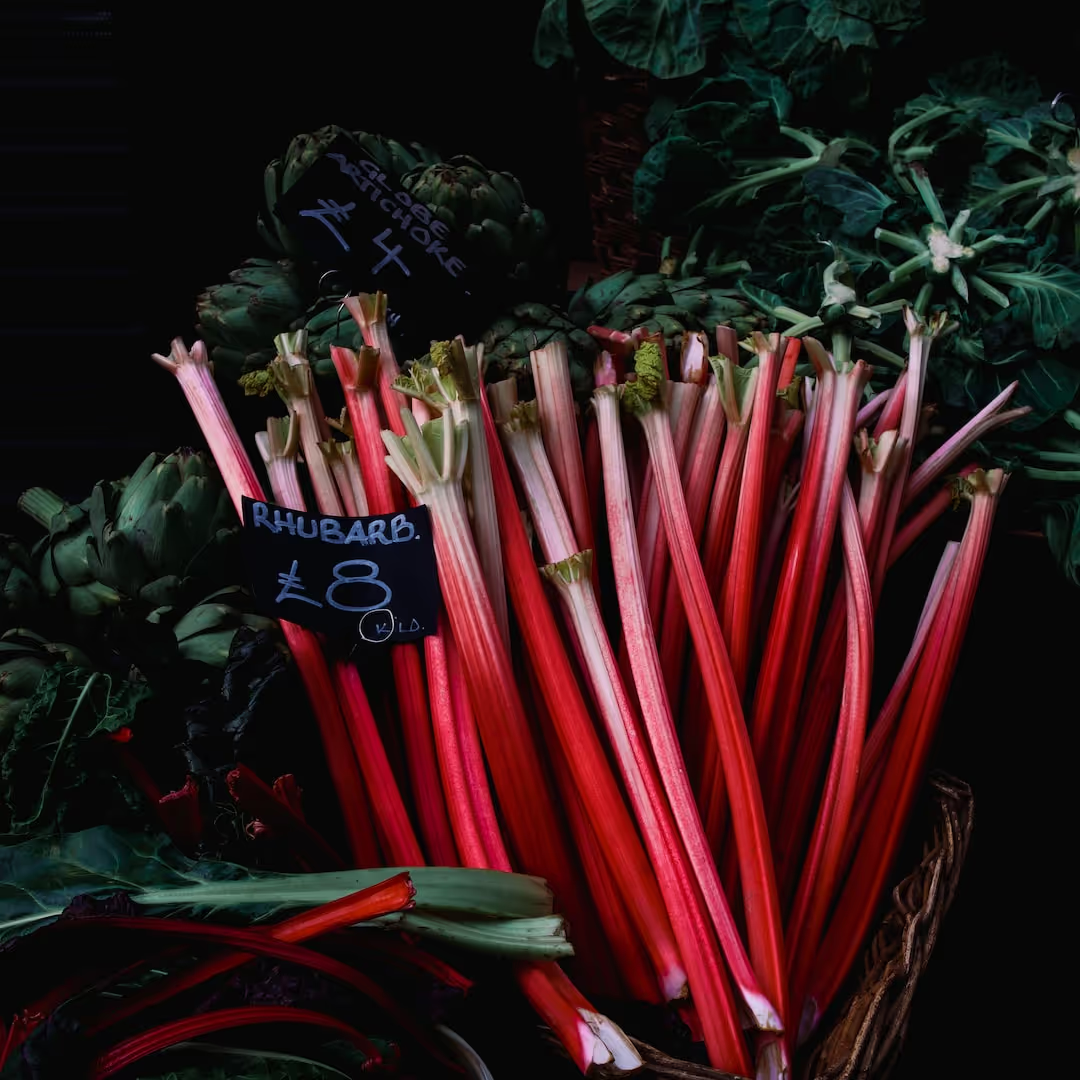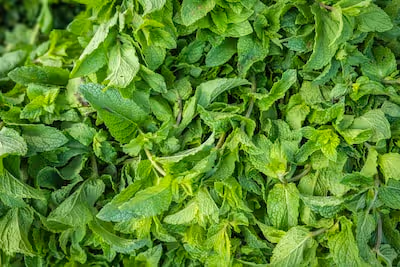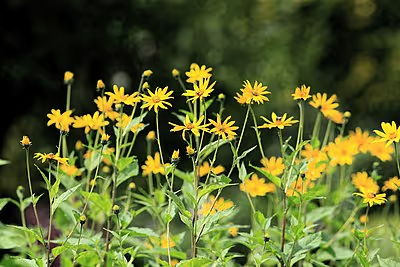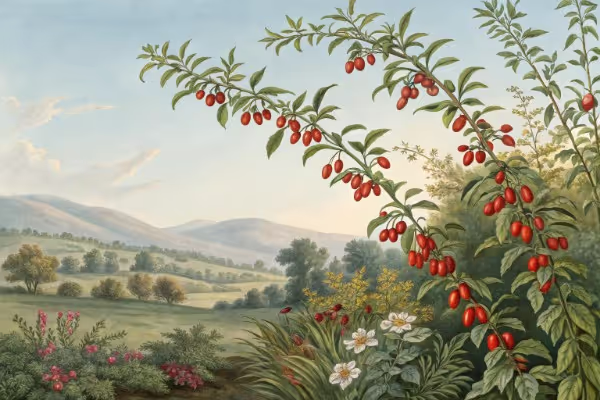Growing Rhubarb: How to Plant, Care, and Harvest at Home

Growing Rhubarb
Growing rhubarb demands sun, fertile soil and savvy timing. Plant crowns in early spring about 3 feet apart, make sure soil drains well and feed generously with compost or aged manure. With minimal fuss, you'll harvest tart, ruby-red stalks perfect for pies, compotes and cocktails—read on to master the delicious art of growing rhubarb.
Cheatsheet: Rhubarb—Planting, Tending & Harvesting Guide
🌱 Planting Rhubarb
- Plant crowns in early spring, soil above 40°F / 4°C
- Choose full sun (6+ hrs); tolerates partial shade
- Space 36 in / 90 cm apart
- Use rich, well-draining soil, pH 6.0–6.8
- Mix in 2–4 in / 5–10 cm compost
- Set crown buds 2 in / 5 cm below soil
- 1 mature plant yields 2–4 lbs (900–1800g) stalks/year
🛠️ Tools and Products You'll Need
- Shovel or spade
- Compost or slow-release fertilizer
- Mulch (straw or bark)
- Sharp knife for harvest
- Rhubarb crowns or divisions
- Watering can or drip system
💧 Care & Feeding
- Water deeply; keep moist but not soggy
- Mulch to suppress weeds & conserve water
- Side-dress with compost each spring
- Remove flower stalks—max stalk production
- Divide crowns every 4–5 years for vigor
✂️ Harvesting Rhubarb
- First year: do not harvest, allow plant to build strength
- Second year: take only a few stalks
- Mature plants (year 3): pick April-June
- Pull stalks with a twist, or cut at base
- Leave at least two stalks per plant
- Never eat leaves—toxic oxalate
🥗 Nutrition & Self-Sufficiency
High in vitamin K, C, fiber, and antioxidants. One cup: 26 kcal, zero fat. Perennial—feeds families for 10+ years.
🚩 Troubleshooting
- Slugs/snails: handpick or use organic pellets
- Crown rot: fix drainage, avoid overwatering
- Red stems=ready; green=needs more sun/time
-
Growing Rhubarb: How to Plant, Care, and Harvest at Home
I grow rhubarb for flavor and attitude. It shrugs off spring squalls and pays in tart, ruby spears that wake the palate like a cymbal crash.
Quick-start for Growing Rhubarb
- Climate: thrives in cool summers and cold winters, USDA Zones 3 to 7, struggles above Zone 8 without shade or forcing.
- Light: full sun in cool regions, afternoon shade in hot pockets.
- Soil: rich, well drained, pH 6.0 to 6.8, high organic matter.
- Spacing: 3 to 4 feet apart, crowns set with buds 1 to 2 inches below soil surface.
- Water: 1 to 1.5 inches weekly, 25 to 38 mm, steady, never soggy.
- Harvest: skip year one, light pick year two, full pick year three.
“Do not harvest during the first year of growth.” University of Minnesota Extension
Soil prep that keeps crowns humming
I lay down 2 to 4 inches, 5 to 10 cm, of compost and work it into the top 8 inches, 20 cm. A shovelful of well rotted manure per plant in early spring sets the tone.
Heavy clay needs drainage fixes, so I mound or use raised beds 10 to 12 inches, 25 to 30 cm, high. Sandy soils get more compost and a thick mulch to hold moisture.
Planting: crowns, divisions, or seed
Crowns are the fast track, planted in early spring as soon as the soil can be worked or in fall in mild zones. I set the crown with eyes up, cover with 1 to 2 inches, 2.5 to 5 cm, of soil, then mulch lightly.
Divisions should have 2 or 3 buds and a healthy slice of root. I divide every 5 to 8 years to refresh vigor and curb crowding.
Seed works, yet it adds a year and genetics drift, so I only sow for breeding projects or oddball colors. For home harvests, I buy certified disease-free crowns from reputable nurseries.
Feeding schedule that actually works
- Early spring: side-dress each mature plant with 1 to 2 cups of balanced organic fertilizer 5-5-5, or 1 to 2 shovelfuls of composted manure.
- After main harvest: add 1 inch, 2.5 cm, of compost and water in.
- Mulch: 2 to 3 inches, 5 to 8 cm, of straw or shredded leaves to keep roots cool and weeds sleepy.
“Rhubarb thrives in fertile, moist soil in full sun.” Royal Horticultural Society
Watering and heat management
I run drip lines and keep the crown itself dry to dodge crown rot. In hot spells above 85 F, 29 C, I give afternoon shade with 30 percent shade cloth and keep mulch deep.
Flower stalks and forced stems
Flower stalks look dramatic, yet I cut them at the base as soon as they appear. You get thicker petioles and better flavor when the plant skips reproduction.
For winter treats, I lift a big crown after frost, pot it, and keep it in darkness at 50 to 60 F, 10 to 16 C. Tender pink stalks arrive in 4 to 6 weeks, a trick backed by RHS forcing guides.
Containers and small spaces
Use a pot of 20 to 25 gallons, 75 to 95 L, at least 16 inches, 40 cm, deep. Fill with a peat-free mix heavy on compost and pine bark for drainage, then feed a little, often.
Container plants dry fast, so check moisture daily in summer. I rotate the pot monthly to balance growth.
My top varieties for Growing Rhubarb
- ‘Victoria’: classic, reliable, green-red stalks, forgiving of uneven care.
- ‘Crimson Red’ or ‘Canada Red’: richly colored stalks, sweet-tart flavor, great for pies.
- ‘Valentine’: stout petioles and clean flavor, handles spring chills.
- ‘Timperley Early’: excellent for forcing, very early harvests in cool climates.
- ‘Glaskins Perpetual’: better heat tolerance and late picking, handy for warm summers.
Pro tip from the patch. Deep red color comes from cultivar genetics, not ripeness, so green-stalked types can taste fantastic.
Care calendar
- Late winter: clear debris, top with compost, set traps for slugs.
- Early spring: feed, water evenly, remove flower shoots.
- Peak spring: harvest stout stalks, never strip the plant bare.
- Early summer: slow or stop harvest once stalks thin to pencil width, let leaves recharge the crown.
- Fall: trim only dead leaves, mulch after a hard frost below 28 F, minus 2 C.
Harvest technique that protects the crown
I grasp a stalk, pull and twist sideways so it slips cleanly from the base. Cutting leaves stubs that invite rot, so I avoid knives at the crown.
I leave at least one third of the stalks on the plant every time. Mature plants can give multiple pickings across 6 to 8 weeks in cool weather.
Established plants often yield 2 to 5 pounds, 0.9 to 2.3 kg, per season in home gardens. University extension summaries
Safety and storage
Leaves are poisonous due to oxalic acid and anthraquinones, so I remove and discard them immediately. Petiole only, always.
Stalks keep a week in the fridge at 32 to 36 F, 0 to 2 C, unwashed in a bag. I freeze sliced pieces on a sheet, then pack for winter baking.
Pests and diseases I actually see
- Rhubarb curculio weevil: chews holes and oozing spots, remove host weeds like curly dock nearby.
- Crown rot Phytophthora: shows as mushy crowns and collapse, fix drainage and avoid overwatering.
- Leaf spots Ramularia and Ascochyta: reduce by spacing, mulch, and morning watering.
- Slugs: thrive under heavy mulch, so I use iron phosphate bait and copper bands in wet springs.
I lean on cultural controls first. Most years that’s enough.
Hot climate tactics
Plant on the east side of a fence for afternoon shade, and keep mulch thick. In Zones 8 to 9, I treat rhubarb as a short-lived perennial or plant fresh crowns and harvest lightly each spring.
Buying guide: crowns, gear, and inputs
- Crowns: order in late winter from a reputable grower that ships bare-root, disease-free stock with 2 to 4 eyes per division.
- Soil kit: pH test, compost by the bag, and coarse bark for structure.
- Fertilizer: balanced organic 5-5-5 or slow-release 4-3-4 for steady feed.
- Water: simple drip line and a battery timer, plus a moisture meter if you like gadgets.
- Forcing: tall pot or forcing bell and a cool, dark corner at 50 to 60 F, 10 to 16 C.
Common mistakes I see in Growing Rhubarb
- Planting too deep or too wet, which invites crown rot.
- Overharvesting in year one or two, which stunts future yields.
- Leaving flower stalks to mature, which drains energy.
- Assuming red equals ripe, then waiting too long and getting stringy stalks.
- Feeding heavy nitrogen late summer, which triggers soft, disease-prone growth.
Answers to questions I’m asked a lot
- Can I eat green stalks? Yes, color depends on variety, taste guides harvest, leaves stay off the plate.
- Can I split and share plants? Yes, divide in early spring or fall with a clean spade and at least two eyes per piece.
- Will frost ruin stalks? Light frost sweetens them, hard freeze turns them limp and watery, so compost those.
- Is seed worth it? For uniform color and flavor, crowns win for most gardens.
Why I keep a rhubarb bed
It’s a set-and-enjoy crop that rewards a little structure with huge personality. I plan the first pie while the snow still squeaks underfoot.
References I trust
- Royal Horticultural Society, Rhubarb cultivation and forcing guidance.
- University of Minnesota Extension, planting, spacing, and harvest timing.
- Penn State Extension and University of Illinois Extension, fertilization and disease notes.
- University of Maine Cooperative Extension, cool-climate performance and variety choices.
Frequently Asked Questions About Growing Rhubarb
What soil conditions encourage rhubarb to thrive?
Rhubarb plants prefer fertile, well-draining soil enriched with organic matter. Incorporate compost or aged manure to boost soil nutrients and aim for a slightly acidic to neutral pH between 6.0 and 6.8.
How much sunlight does rhubarb require to grow?
Rhubarb flourishes best in full sun conditions, ideally receiving at least 6 to 8 hours of direct sunlight daily. However, it tolerates partial shade, especially in hotter climates.
What's the ideal time to plant rhubarb?
The optimal planting period for rhubarb is early spring or late autumn, when temperatures remain cool and moderate—around 40°F to 60°F (4°C to 16°C). This timing allows the plants to establish sturdy roots before extreme weather arrives.
How much space should I allow between rhubarb plants?
Provide ample space by positioning rhubarb crowns approximately 3 to 4 feet (90 to 120 cm) apart. This spacing ensures adequate airflow, reduces disease risk, and promotes healthy foliage and stalk development.
How often and how much should rhubarb be watered?
Water rhubarb regularly, delivering approximately 1 to 2 inches (2.5 to 5 cm) of water weekly, particularly during dry spells. Consistent moisture supports steady growth without causing root rot or fungal diseases.
When is the best time to harvest rhubarb stalks?
Harvest rhubarb stalks from the plant’s second growing season onward, typically from late spring through early summer. Select robust stalks at least 10 to 12 inches (25 to 30 cm) in length, pulling gently while twisting to detach cleanly from the crown.
Are rhubarb leaves safe to compost?
Yes, rhubarb leaves can safely contribute to the compost pile. Although toxic for human or animal consumption due to high levels of oxalic acid, decomposition breaks down this compound, posing no issues for your garden compost.
What steps ensure healthy rhubarb throughout the growing season?
Maintain strong and productive plants by regularly removing flower stalks as they appear, applying mulch to retain moisture and reduce weeds, and replenishing soil fertility annually with compost or organic fertilizers.
Growing Rhubarb is a lesson in patience and reward. Give it rich soil, ample space, and a bit of restraint—skip the harvest the first year, and it’ll pay you back for seasons to come. Water deeply, mulch generously, and keep an eye out for weeds. Snip the stalks clean and leave the leaves behind. With a little respect for the plant’s rhythms, you’ll have tart, ruby stalks ready for pie, compote, or something a little more adventurous. If you’re hooked on perennial crops, you might also enjoy growing asparagus. Good soil, patience, and a sharp knife—the rest is just letting nature do its thing.
The Homesteader's Take on Growing Rhubarb: Essential Sustainability Practices
Maximize Self-Sufficiency with Rhubarb
- Perennial benefits: Rhubarb provides reliable harvests for 8–10 years from a single planting, reducing annual labor and seed costs.
- Space efficiency: Plant rhubarb crowns along garden edges or beside perennial herbs to optimize small homestead plots.
- Natural fertilization: Nourish with homemade compost or aged manure to improve soil fertility sustainably every spring.
Boost Nutrition and Health Naturally
- Vitamin-rich harvest: Rhubarb stalks contain calcium, vitamin K, vitamin C, and fiber, supporting bone health and digestion.
- Medicinal application: Historically, rhubarb roots served as medicinal laxatives—today, consume cooked stalks moderately to aid regular digestion.
- Preservation practices: Dehydrate rhubarb slices or freeze chopped stalks for year-round nutritious meal additions without preservatives.
Repurpose Rhubarb Leaves Effectively
- Pest-deterring spray: Boil rhubarb leaves in water (1kg leaves per 3 liters water or 2 lb per 0.8 gal), strain, and apply cooled mixture as natural insecticide against aphids and spider mites.
- Composting safely: Compost rhubarb leaves safely; oxalic acid naturally breaks down during decomposition, avoiding waste and enriching compost nutrient diversity.
Economic Advantage and Income Potential
- Farmers' market favorite: Rhubarb typically sells at $4–$6 (€3.50–€5.50) per pound; bundle fresh or frozen stalks to supplement homestead income.
- Value-added products: Expand profit margins producing homemade rhubarb jams, sauces, or pies which command higher market prices.
Find out which plants will thrive in your garden!
Answer a few fun questions and get custom plant recommendations perfect for your space. Let’s grow something amazing together!

start your season





